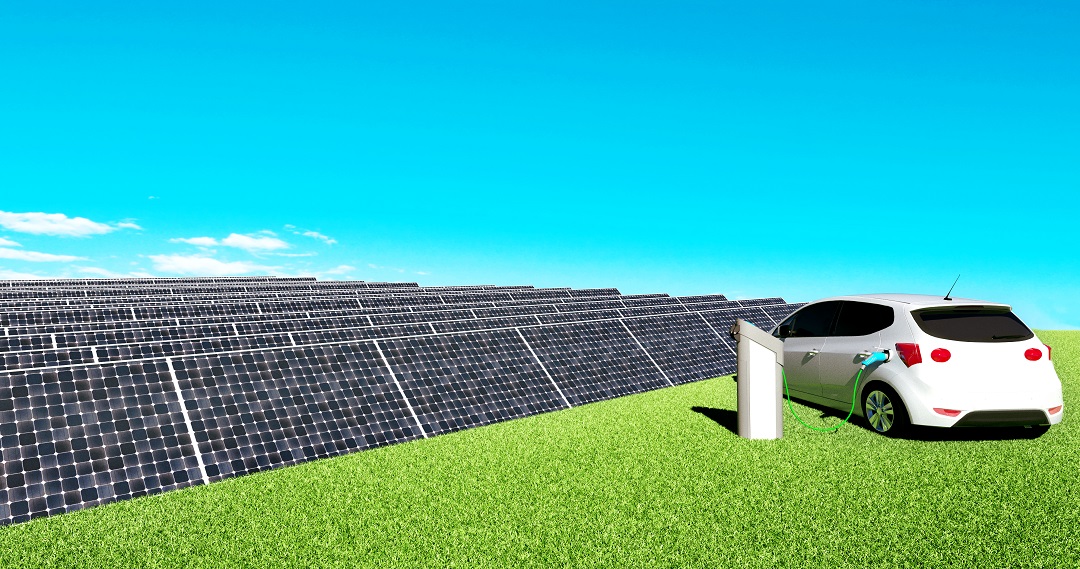
European and Japanese automakers are forging a path toward sustainable energy with the development of symbiotic vehicle-to-grid systems that can help to stabilize the supply of electricity from renewable energy sources.
* * *
With the European Union set to apply strict new emissions targets for passenger cars in 2021 (95 grams of carbon dioxide per kilometer), forward-looking automakers are busy preparing for a massive shift away from fossil fuels. This trend is seen in the growing emphasis on electric vehicles (EVs) and, most recently, in ambitious initiatives to marry e-mobility with the use of renewable energy. In the following, I survey these developments with reference to highlights of the Geneva Motor Show.
Nissan’s Vehicle-to-Grid Vision
At the 2018 Geneva Motor Show, Nissan Motor Co. announced that it was embarking on a strategic energy-solutions partnership with the German electric utility company E.ON. As part of its long-term strategic vision for “intelligent mobility,” Nissan is working with E.ON on integrated energy solutions, including vehicle-to-grid (V2G) technologies.
V2G is a system that integrates EVs into the power grid in a way that helps stabilize the fluctuations in power from renewable energy sources. One of the obstacles to a wholesale shift from fossil fuels to renewable energy—needed to reduce carbon emissions and stem global warming—is the challenge of “smoothing” the flow of electricity from sources like solar and wind power, which fluctuates according to weather conditions, in order to balance supply and demand. One approach is to store surplus energy in large, stationary battery banks for later use, but such facilities are costly.
A V2G system can use the batteries installed in EVs—including fully electric and plug-in hybrids—for that purpose. Given sufficient market penetration of such cars (most of which will be parked at any given time) and a sophisticated network connecting them to the power grid, it should be possible for the EVs to exchange electricity with the grid in such a way as to smooth the supply of electricity from renewable energy and balance it with demand.
This is the vision behind Nissan’s project. Of course, there would be benefits for Nissan users as well. The company envisions a business model in which the drivers of electric cars are not just electricity consumers but also suppliers of a service—stabilization of the power grid—and are compensated accordingly. As Paul Willcox, chairman of Nissan Europe, explained it, Nissan’s “ultimate ambition [is] to provide free electricity for our EV customers.”
Volkswagen’s Portable Recharging Stations
Nissan is not the only automaker eyeing the integration of clean energy and e-mobility. A number of promising technologies geared to just such a marriage were on display at the March 2019 Geneva Motor Show.

One was Volkswagen’s mobile quick-charging “power bank” for electric vehicles, which the company plans to begin mass-producing in 2020. With a total charging capacity of up to 360 kilowatt hours, each mobile charging station is equipped with its own rechargeable battery pack, for flexible installation independent of the power grid, and two AC and two DC connections, which can be used simultaneously. When connected to a renewable power supply for recharging, it can temporarily store surplus power for electrical load balancing, thus contributing to sustainable, carbon-neutral mobility. Moreover, since the batteries used in the mobile charging stations and those used in Volkswagen’s EVs themselves will be mutually compatible, it will be possible to recycle exchanged vehicle batteries for use in the mobile charging stations.
Audi, meanwhile, is arguably the world leader in advanced initiatives for integrating e-mobility and renewable energy. Since 2013, a plant in Werlte in northwestern Germany has been using surplus power from a wind farm to produce hydrogen from water by hydrolysis. It then uses the hydrogen, along with carbon dioxide captured from the air, to produce synthetic methane, or “Audi e-gas,” which powers the automaker’s “g-tron” family of vehicles. This plant not only produces eco-friendly fuel but also contributes to the stabilization of Germany’s power grid by adjusting its operations to the electrical load.
Another pioneering initiative is the Audi Smart Energy Network, announced in January 2018. Under this pilot project, currently underway in Ingolstadt, Germany, and Zurich, Switzerland, Audi and its partners have linked various photovoltaic systems (primarily domestic) with EV charging stations and other stationary storage batteries to create a smart distribution system that supplies power for electric cars, household appliances, and heating systems. The network also interacts with the public power grid to balance supply and demand and stabilize the grid amid fluctuations in output from renewable energy.
At the 2019 Geneva Motor Show, Audi’s focus was squarely on “electrification,” as it showcased its Audi “e-tron” family and other electrified cars. The company is rapidly expanding its lineup of such vehicles, which it hopes will make up a third of all new Audis sold by 2025. If all goes according to plan, many of those cars will be integrated into the Audi Smart Energy Network.
From Concept to Reality
The basic impetus for the new wave of EVs is the advent of increasingly stringent emissions standards, particularly with respect to carbon dioxide. But to achieve zero-emissions mobility it is not enough to power cars with electricity; we must also find ways of reducing emissions from the generation of that electricity. In that sense, the expanded use of renewable energy is a prerequisite for the long-term success of electric cars. Yet to make widespread use of renewable energy practical, we must meet the challenge of load balancing to stabilize a power grid dependent on variable energy sources. One important way to accomplish this is by expanding the market penetration of EVs and plugging them into the power grid.
For the past few years, a number of automakers, cognizant of these intertwined imperatives, have been experimenting with V2G systems that integrate electric cars and their batteries into the power grid. And now some have moved from experimentation to implementation. Europe may be leading the way, but Japan—despite its slow progress on renewable energy—is not so far behind.
In the second half of 2019, Honda plans to begin production of the Honda e, an all-electric urban car unveiled at the 2019 Geneva Motor Show. This year Honda also introduced improvements in the Honda Power Manager Concept (initially unveiled at the 2017 International Motor Show in Frankfurt), featuring bi-directional V2G technology that would allow EV owners to supply power to the grid at peak load times. Honda is currently working with the Swiss firm EVTEC, a provider of EV charging technologies, to commercialize a bi-directional energy transfer system over the next few years. Honda also made a splash at the 2019 Geneva Motor Show by announcing its intention to “
When assessing the environmental impact of EVs, plug-in hybrids, and fuel-cell vehicles, experts typically compare the lifecycle emissions (and other impacts) associated with the production, operation, and disposal of individual vehicles. But with the integration of e-mobility and renewable energy, we will need to look beyond the emissions of individual cars and begin assessing the efficacy of automobiles as part of a system for promoting the efficient use of low-emissions renewable energy.


